Reverse Engineering: AlSmizzle's MLB Heater

“The heater continues.”
That was the closing line of the e-mail I received from Al Zeidenfeld on Monday evening after the MLB games for the day had ended. To be fair to the man widely known as Al_Smizzle, he wasn’t e-mailing me just to rub it in my face that he finished second in the Monster on FanDuel and killed his cash games for the day. Instead, he was following up on a conversation we had in my interview with him right after lineup lock.
“I’m so tilted,” was the first thing out of Al’s mouth in our conversation. For the second time in about a week, Al had a very successful lineup going with a player who wasn’t in the starting lineup. He made a simple misclick and didn’t come back to the page in time to correct it, and left the not-starting Jed Lowrie in his FanDuel lineup on Monday night.
As it would turn out, that lineup would do just fine anyways. So would his other lineup featuring a benched player that he submitted over the course of the first week of the MLB season. Because right now, Al is on a ridiculous heater in baseball, and was kind enough to take some time to talk to me about his lineups and his approach, even in the midst of another successful night.
The Heater Begins
You can trace Al’s success over the first week of the MLB season all the way back to the first Tuesday of opening week, when Al put together a 50-point cash game lineup that cleaned up in cash games and double ups.
April 7th, Cash Game
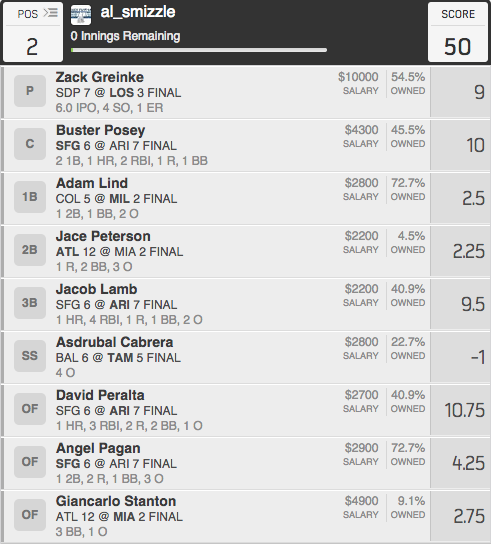
“I want the best pitcher at the best price,” was the summary of Al’s cash game approach on FanDuel. And on the second day of the season, with most team’s number two starters on the bump, that wound up being Greinke. The Dodgers hurler proved to be the best cash game option available, coming through with a good enough line for the majority of users in most double-up contests that used him. There were better pitchers on the day, but the six innings of one-run baseball were justification for his high ownership.
As for the batters? Al looks for advantageous situations for his hitters in cash games, and tries to stack up as many as possible. “I’m not talking stacking like, multiple players from the same team,” he reminded me, but rather stacking players from his research that hold statistical advantages in their daily matchups. This is one of the key’s to Al’s approach, and one that may change the way you view baseball as a fantasy sport.
Zeidenfeld uses percentages to express his daily projections, finding the ratio above or below average that a hitter or pitcher should be expected to perform in their matchup for the day. He says that due to the very volatile nature of baseball, with a huge failure rate for even the best players, trying to predict points or dollar per point can often prove to be foolish.
“If you fail 70% of the time in baseball, you’re an All-Star,” Al told me, and that’s a great reminder of the nature of batters in the league. Even in an ideal matchup where a hitter may get on base at a .350 or .400 clip, that still means over 60% of his at-bats are going to end in disappointment and a negative fantasy result.
April 8th, Cash Game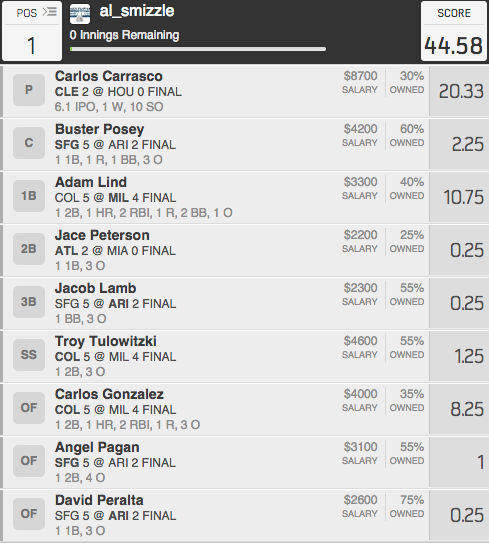
“I will absolutely stream against a team.” Carrasco was the first of two key pitching selections Zeidenfeld has made over the past week that came against the Houston Astros. “I am always looking for strikeout potential in my pitchers,” he told me, adding that he also looks at park factors and other variables, but the upside for strikeouts remained a constant in his cash games.
Al told me that “99 times out of 100,” he wants a stud pitcher in his cash game lineups. Especially on FanDuel, where the scoring is set up in a way that favors pitchers just a bit more, but even on DraftKings, with the two-pitcher setup and higher upside for batters. “The variance with pitchers is way lower than with hitters.”
April 8th, Tournament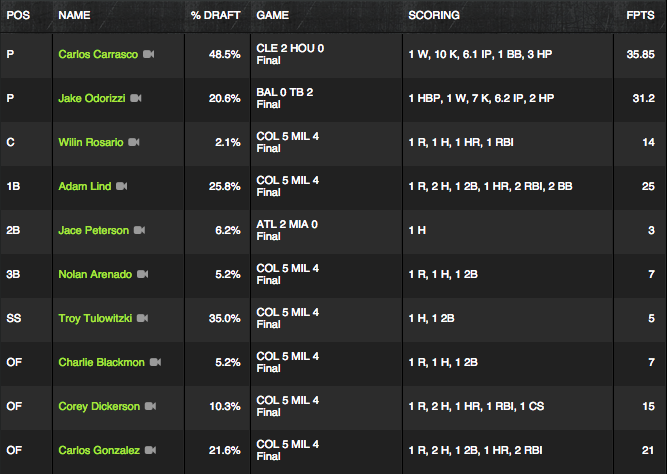
Carrasco came through for Al in tournaments, as well, as he brought in plenty of winnings with this lineup on DraftKings. And the strikeout upside for the Indians pitcher is obvious, especially against a team like Houston, but what led to the Odorizzi pick?

Strikeout potential. A negative park situation for Baltimore. The boom-or-bust nature of the Orioles’ lineup. “Home-run hitting teams take chances. They strike out,” Al told me in relation to his selection of the Tampa Bay pitcher, who was facing a lineup with some intimidating lefties. His price was cheap enough to make the risk of big bats like Chris Davis taking Odorizzi deep worth it, with strikeout potential to provide points at a great cost. “I was just thinking he’d get me six innings and six or seven strikeouts.”
And sometimes it takes a bit of luck to win a tournament. You may notice in the lineup above that Wilin Rosario is much lower owned than his Colorado teammates. That’s because he wasn’t in the starting lineup on that day. Al was so caught up in making sure that players from games with weather threats were out of his lineups that he missed the news that Rosario had been removed from the starting lineup, but his pinch-hit appearance delivered a home run and enough points to move him from fifth to first in the GPP.
Chasing Overlay from the Ballpark
On Friday of last week, Al was spending time with fellow well-known grinder CSURam88 ahead of his Daily Fantasy Bootcamp in Denver, and the two were going to be at the Rockies game that day. Obviously this meant building lineups ahead of time, so Al and Pete set their rosters and headed out to Coors.
But while Al was at the game, he checked the DraftKings app on his phone and noticed a ton of overlay in GPPs, and decided he wanted some more action in those games. So he doubled his entries in tournaments, and then went in and made one-for-one and two-for-two changes in every lineup to provide some differentiation.
That led to these two lineups.
April 10th, Tournaments
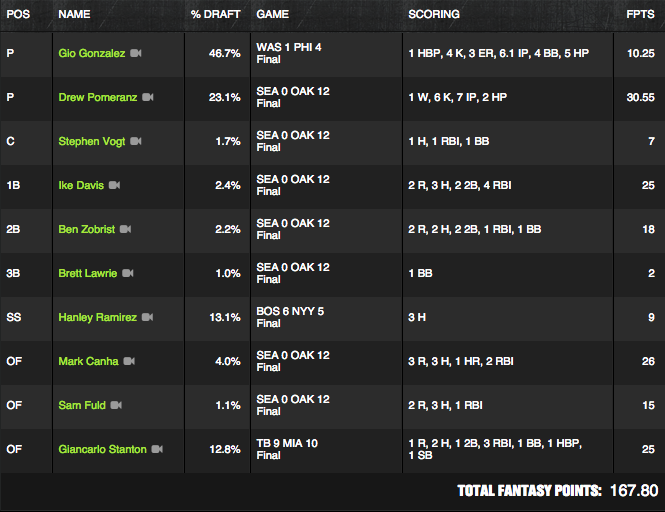
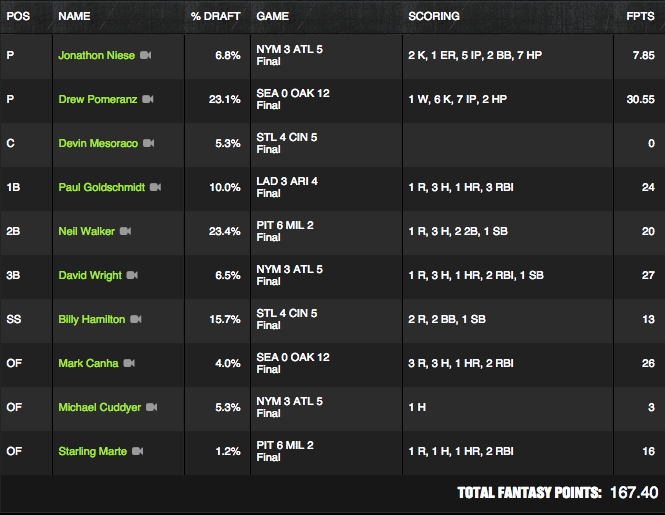
The first lineup, you may notice, has a low-owned A’s stack. Oakland was facing Seattle youngster Taijuan Walker on the day, and while some players saw Walker as a pitcher to start, Al saw him as an opportunity for a stack. “His velocity was down in the spring,” he told me, and with some capable left-handed bats in the A’s lineup, it was an easier call to make than the low ownership percentages may indicate.
And while the A’s stack was huge, the selection of Giancarlo Stanton also unlocked this lineups’ potential. Al says this is because he doesn’t overlook the “other” players when stacking in tournaments. Stanton was a core play for Zeidenfeld on the day, and he would try to leave an outfield spot open in his stacks to fit in the talented Miami slugger. If you get the “plus-one” players in tournaments right, Al told me, it raises the floor of your lineups and allows your stacks that hit to really challenge in GPPs.
The second lineup doesn’t have a stack at all. Why’s that? It’s a lineup that he put together on his phone walking from Coors Field, and was based on a previous lineup with some players swapped out and shifted around. It wound up being just a list of players he liked on the day, who he believed had advantages in their matchups.
The Heater Continues
At this point, Al has posted several cash game lineups that swept up nearly every contest he entered, and has multiple tournament finishes that gave him exponential return on his investment. And with his Denver bootcamp taking place on Saturday, that just gave him another opportunity to dive into a slate (with the attendees of his camp) and put together lineups like this one.
April 11th, Tournament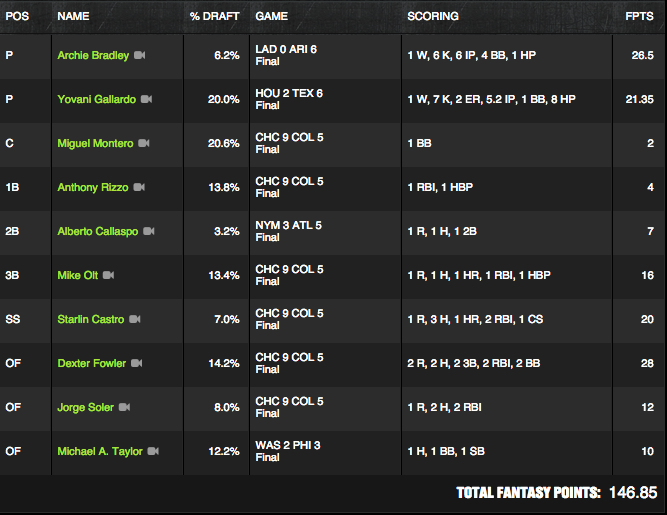
“Madison Bumgarner was my top pitching target for that day,” he said, but this tournament lineup wound up succeeding without the Giants’ ace, who didn’t perform up to expectations. So how did he settle on Bradley and Gallardo? Both were players he was pairing with Bumgarner in cash games, and for a tournament, he paired them with one another to afford more bats.
“Doug Fister had no strikeout potential, I didn’t like Dillon Gee against the Braves (who were doing better than most people gave them credit for), and that led me to Gallardo as the safest pick in that range of pitchers.”

And as for Bradley?
“On DK, I don’t need the win.” Bradley was going up against Clayton Kershaw, but that didn’t scare Al away from rostering the young Arizona starter. “I’ll take the extra four points if you give them to me, but really I just want good pitchers with strikeout potential.” Bradley was a bit of a risk, but for a tournament lineup, he offered differentiation from the field, and still had favorable numbers in Al’s projections.
This leads to what was maybe the most powerful takeaway from my conversation with Al. The concept of being “contrarian” in tournaments.
“Contrarian doesn’t mean bad plays, just a good combination no one else has.”
“You have to be willing to do what your opponents won’t.”
Al says that this is why tournaments are his favorite aspect of DFS, because it allows him to manipulate the metagame as well as use his proven projections to select the right players. A Cubs’ stack was priced through the roof on Saturday, but picking Bradley as a starter along with Gallardo opened up the cash to stack nearly all of the relevant Chicago bats, which paid off for Al. None of the Cubs were “contrarian” on their own, but having them in such large amount, and with two pitchers outside of the top tier who both hit, led to a huge payday.
“You don’t have to try to be contrarian,” Al told me, and mentioned that when he trusts his research and finds a guy that isn’ being talked about by other analysts and writers, he feels confident in that player as a strong tournament play. “Group think,” as Al called it, leads to ignoring good options and playing poor ones just because everyone else is doing it. When a player has a solid system in place for scouting baseball, as Al does, those numbers can show good plays that shouldn’t be contrarian, but are thanks to popular opinions about other options on the slate.
This usually means picking guys right below the surface. To use an example in football, while Al might not start Aaron Rodgers against the Seahawks, he would against the Cardinals or another strong defense that isn’t elite and game-changing. Great offensive talent can still score points in less-than-ideal matchups, and that is a strategy that carries over into baseball.
This is where the idea of even the best players having a 70% failure rate comes back into play. If a strong, talented lineup like Detroit is facing a good, but not elite, starting pitcher, they’re still likely to succeed, and will do so at a lower ownership than usual. This puts you on the “right side of the math, according to Al.
One of the concepts he stressed was the idea of being on the right side of the odds with popular plays. If a top batter is going to be 40% owned, but he’s only going to “succeed” at the plate 30% of the time, what are you doing with him on your roster? Your odds of success should be higher than the percent of ownership in tournaments, as this unlocks upside while avoiding falling into the same tilting downside everyone else may wind up with. He says there are plays that are so obvious that it’s worth the block, but often it’s worth breaking away from the crowd in tournaments and going with other “good” plays that offer more upside against the field.
April 13th, Cash Game and Tournament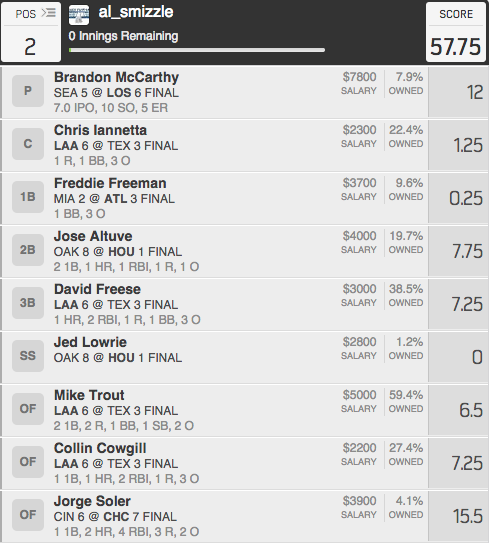
“I’m like, the only guy with Soler in cash.” Al really liked Jorge Soler on Monday night, featuring him in lineups he set moments before our interview. The Cubs youngster had a solid line drive rate (one of the stats Al likes to use, “It shows he can hit the ball hard.”), and had favorable numbers in his projections. Minutes after our interview, Al e-mailed me to point out Soler’s first-inning home run, and would send along news of yet another huge day at the office thanks in part to going with the Chicago outfielder.
Soler was only 4% owned in the GPP shown above, and his huge night provided the fuel to move Al up the leaderboards once again on Monday evening, continuing his ridiculous hot streak to start the MLB season. This was a cash game lineup that he entered into a GPP, and it paid off in both formats for another huge payday.
Can Al keep it going? His projections have nailed almost every day of the season so far, and his understanding of the metagame of DFS seems to be as strong as ever. Because for Al, baseball is a simpler DFS offering, and one he has a pretty good understanding of.
“Can this hitter hit this pitcher? Can this pitcher strike out these batters?” Two fairly simple questions that summarize the lack of schemes and game plans in baseball, when compared to other DFS sports. Finding the right tools and statistics to predict the answers to those two questions is the key to success in cash games, and finding the right way to put those players into different combinations in lineups is the key to tournaments.
And through one week of the MLB season, it’s clear that Al has both of those elements of the sport under control. How long can he keep it up?